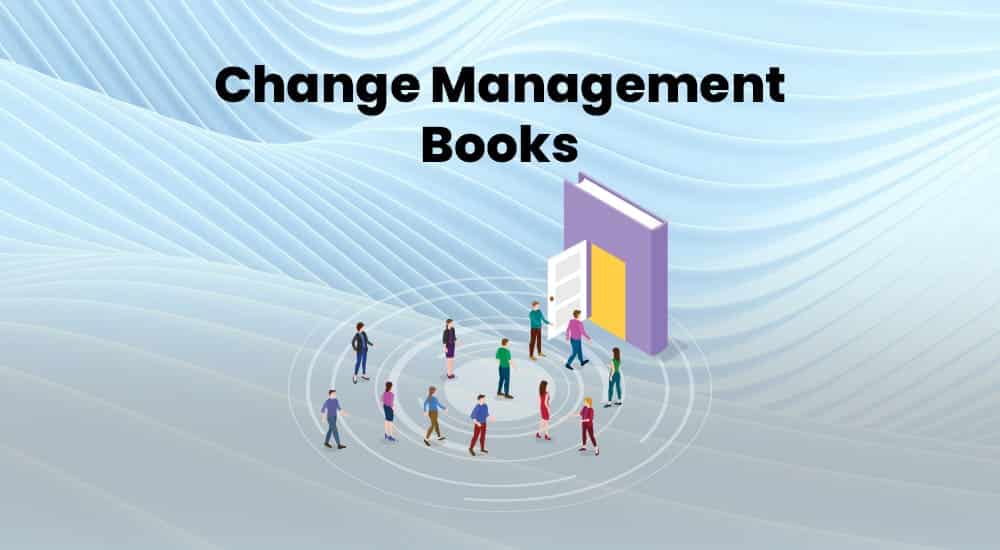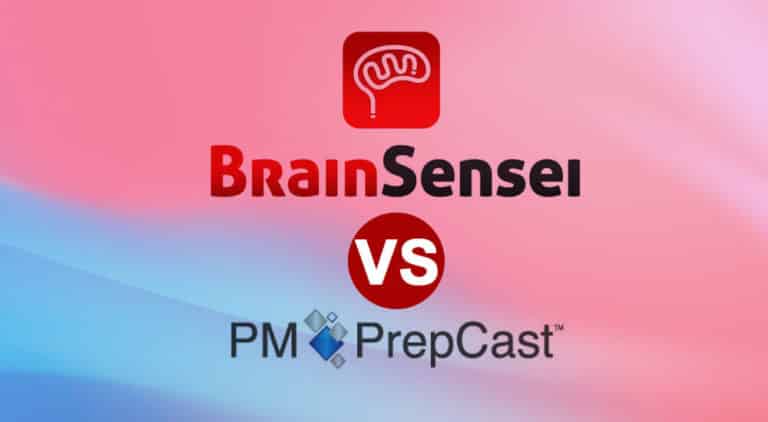If you are looking for the best change management books, you landed at the right place, as today we will discuss 9 popular books on change management.
In the dynamic landscape of today’s business world, change is the only constant. Consistent change shapes the way organizations operate and evolve. The ability to adapt, innovate, and manage change effectively has risen to the forefront of strategic imperatives for businesses aiming to remain competitive and resilient.
Change, however, is never a straightforward journey. Challenges, uncertainties, and human complexities demand a nuanced understanding and a thoughtful, holistic approach. And for the same, project managers need to dissect its intricacies and devise methodologies to lead successful transitions.
This article will discover how professionals can learn change management through the top 9 change management books.
What is Change Management?
Change management is the structured and strategic process of transforming individuals, teams, and organizations to achieve the desired business goals. It includes planning, addressing resistance management, crucial conversations, facilitation of skill development, stakeholder engagement, monitoring progress, and ensuring the integration of new practices/technologies.
This is done to minimize disruption and maximize the positive impact of change initiatives and the resulting productivity. Furthermore, the primary purpose of change management is to implement strategies that effectively implement change, control the change, and help people adapt to the change.
Top 5 Benefits of Understanding Change Management
- Effective Transition: Significant insights into change management enable professionals to navigate transitions seamlessly. This reduces business disruptions and maintains productivity during periods of change.
- Minimized Resistance: Understanding change management allows professionals to anticipate and address resistance. This fosters a receptive environment among stakeholders and employees to facilitate smoother implementation.
- Enhanced Communication: When a professional thoroughly understands change management, it equips them with refined communication skills, ensuring clear, empathetic, and persuasive interactions with colleagues, clients, and teams throughout the change process.
- Strategic Planning: Grasping change management principles enables professionals to strategically strategize and execute change initiatives. This further helps maximize individual benefits and business profits and minimize risks through well-structured plans.
- Adaptive Leadership: With change management insights, professionals can exhibit adaptive leadership qualities. Such qualities inspire confidence, help guide larger teams, and foster a culture of resilience and growth amid evolving circumstances.
Top 9 Change Management Books
#1. Managing Transitions: Making the Most of Change by William Bridges and Susan Bridges
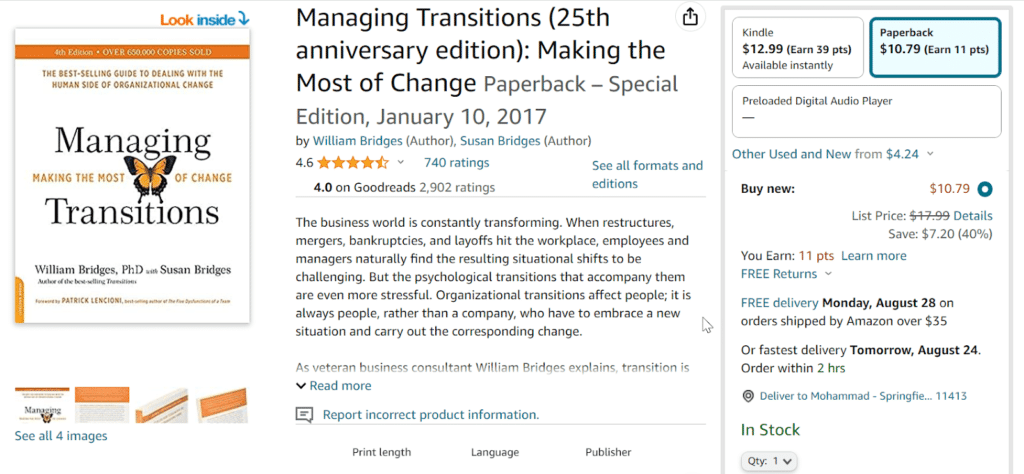
Managing Transitions by William Bridges and Susan Bridges delves into the emotional and psychological aspects of change management in business dynamics. This effective change manager’s handbook focuses on the human side of transitions. It emphasizes the importance of understanding and addressing the emotional mind responses people have during times of change and how to navigate through those responses.
It provides practical guidance on navigating the psychological transition journey and offers strategies for effectively managing resistance and facilitating successful change.
USP: This book distinguishes itself by focusing on change’s emotional and psychological dimensions, offering a deeper understanding of how individuals experience and adapt to change. Hence, it has more of a ‘human’ touch than other books. It also highlights the significance of guiding people through the emotional stages of transition, making it a practical resource for leaders seeking to lead with empathy and sympathy.
#2. Leading Change by John P. Kotter
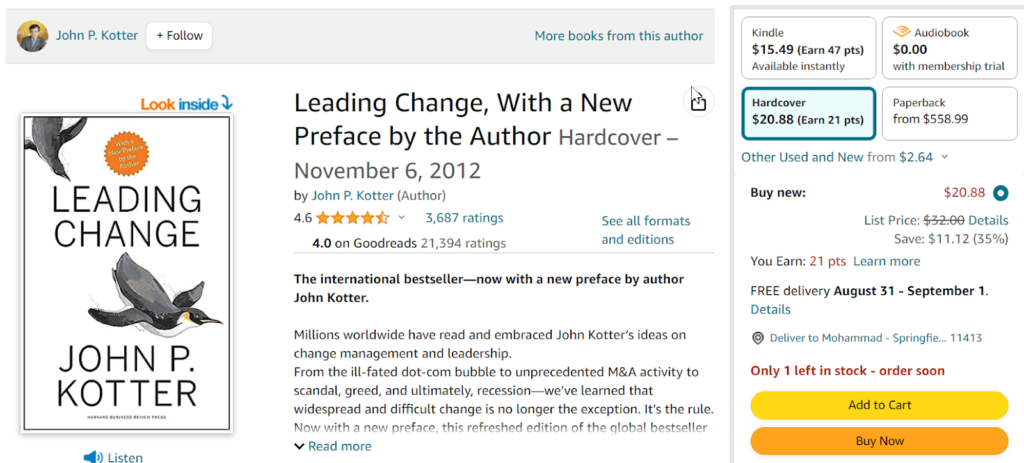
John Kotter is a prominent figure in change management, and this book outlines his eight-step process for leading successful change management initiatives. The book emphasizes urgency, strong leadership, and effective communication throughout the change process.
Kotter emphasizes that clear and consistent communication is the linchpin for aligning stakeholders and employees, fighting uncertainties, and fostering active participation. By elucidating how to maintain a continuous and open dialogue, the book underscores communication as a foundation for change readiness.
USP: This book’s uniqueness lies in its detailed, step-by-step approach to change management. It provides a clear roadmap for leaders, making it a practical guide for implementing change initiatives more structured and effective than other books.
#3. Our Iceberg Is Melting: Changing and Succeeding Under Any Conditions by John Kotter and Holger Rathgeber
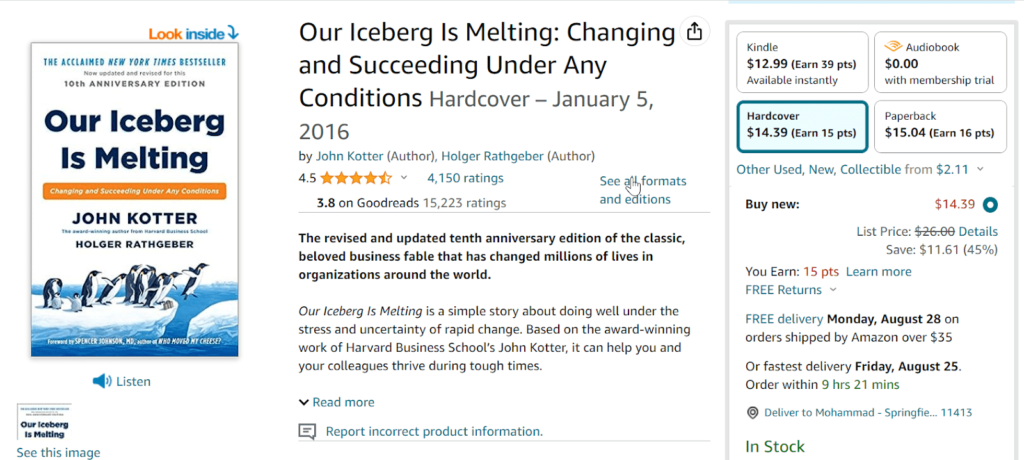
Published in 2005, Our Iceberg Is Melting is a unique book that takes a creative and engaging approach to presenting essential change management principles through the lens of a fable.
The book’s central narrative revolves around a colony of penguins living on an iceberg. The penguins suddenly discover that their home, the iceberg, is melting. This dire situation prompts the need for change and adaptation. As the penguins grapple with this impending crisis, they embody various personas representing common attitudes and behaviors mirroring different individuals in organizations when faced with change.
The book introduces characters with distinct personalities, responses, and attitudes toward the melting iceberg and the necessity for change. The characters’ interactions and challenges reflect people’s responses when confronted with change, both individually and collectively, in or outside an organization.
USP: The book stands out for its storytelling approach, making change management principles accessible and relatable to a wider audience. There are hardly any other books in the market following a storytelling approach, making this one a unique pick. It combines the power of storytelling with practical insights, making it an excellent choice for individuals who prefer learning through narratives as a step-wise guide.
#4. Switch: How to Change Things When Change Is Hard by Chip Heath

The Switch is a best-selling book written by Chip Heath and Dan Heath. Published in 2010, the book explores the challenges of enacting change, whether personally or within organizations, and provides a practical framework for navigating these challenges.
At its core, Switch delves into the psychology and neuroscience behind why change can be so challenging for individuals and groups, and it offers actionable strategies to overcome resistance and drive successful change initiatives.
The framework introduced in the book is the “Rider-Elephant-Path” model, which serves as an analogy for understanding the dynamics of change. The book illustrates these concepts through a wide range of real-life examples and case studies, showcasing how individuals and groups in an organization have successfully applied the Rider-Elephant-Path framework to achieve meaningful change.
By understanding the psychological underpinnings of resistance and leveraging the principles outlined in the book, individuals and leaders can better navigate the complexities of change and drive positive outcomes.
USP: What sets this book apart is the distinctive “Rider, Elephant, Path” analogy. This analogy offers a remarkable and applicable framework for comprehending the complexities of change through emotional and rational lenses. The analogy links the human experience of change to a Rider (representing our rational mind), an Elephant (symbolizing our emotional aspect), and a Path (referring to the context in which change occurs).
This metaphor illustrates how successful change involves guiding both the rational and emotional sides while considering the environment that shapes behavior, unlike any other book.
#5. Change (the) Management: Why We as Leaders Must Change for the Change to Last by Al Comeaux
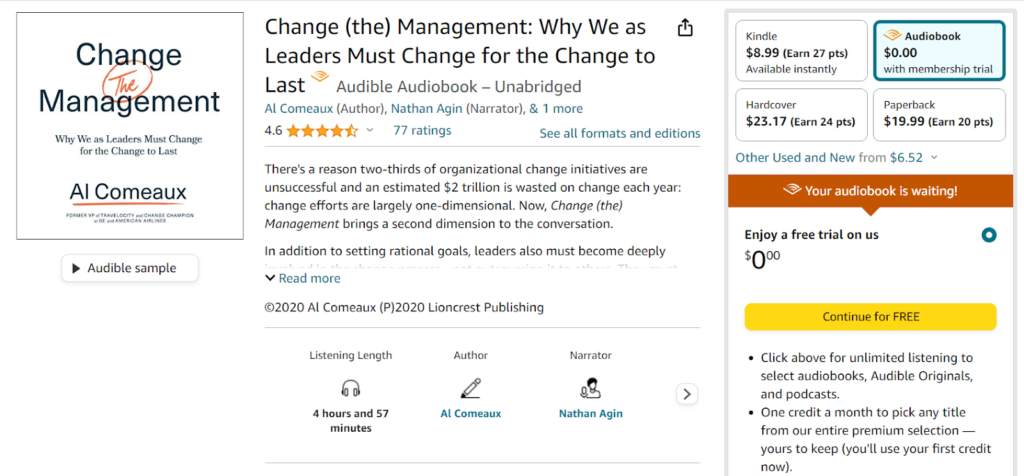
In this book, the author advocates for leaders to lead through actions, behaviors, and attitudes aligned with the desired changes. He provides a powerful framework for sustainable change. This approach fosters a sense of change management through unity, authenticity, and credibility within the organization.
The book’s central message is that change begins at the top level. Leaders must lead the change and demonstrate a genuine commitment to live and work through it. This involves communicating transparently, aligning personal values with organizational objectives, and adapting behavior to reflect the desired change.
Comeaux challenges leaders to embody the changes they seek, promoting a shift from dictating change to implementing it themselves. Leading by example becomes the cornerstone, as leaders’ actions and attitudes drive authentic and enduring transformation.
USP: This book’s distinctive aspect is its emphasis on personal leadership transformation as a cornerstone of effective change management. It highlights the critical connection between leadership behavior and the lasting impact of change initiatives rather than treating change as an isolated process.
#6. HBR’s 10 Must Reads on Change Management Harvard Business Review

HBR’s 10 Must Reads on Change Management from Harvard Business Review is a comprehensive anthology that delves into the intricate process of change management. Bringing together a diverse array of Harvard Business Review articles, this compilation provides a rich tapestry of perspectives and insights, catering to the multifaceted nature of organizational change.
The book gathers the collective knowledge of numerous thought leaders, offering a pool of strategies, philosophies, and tactics that collectively encompass the spectrum of change management. It also includes some past articles by HBR, like “Leading Change When Business Is Good,” “Radical Change, The Quiet Way,” and more.
The anthology doesn’t merely present a one-size-fits-all approach; it recognizes the complexity of change and equips readers with a multifaceted toolkit to tackle its multifarious dimensions.
USP: The book stands out from other books in the market due to its unique approach of gathering top articles from Harvard Business Review’s renowned experts. This compilation offers a diverse range of viewpoints and insights from leading thinkers in the field.
Unlike single-author books, this anthology provides a comprehensive overview of change management, presenting a variety of strategies and perspectives in one cohesive package by several authors.
#7. Leadershift (The 11 Essential Changes Every Leader Must Embrace) by John C. Maxwell
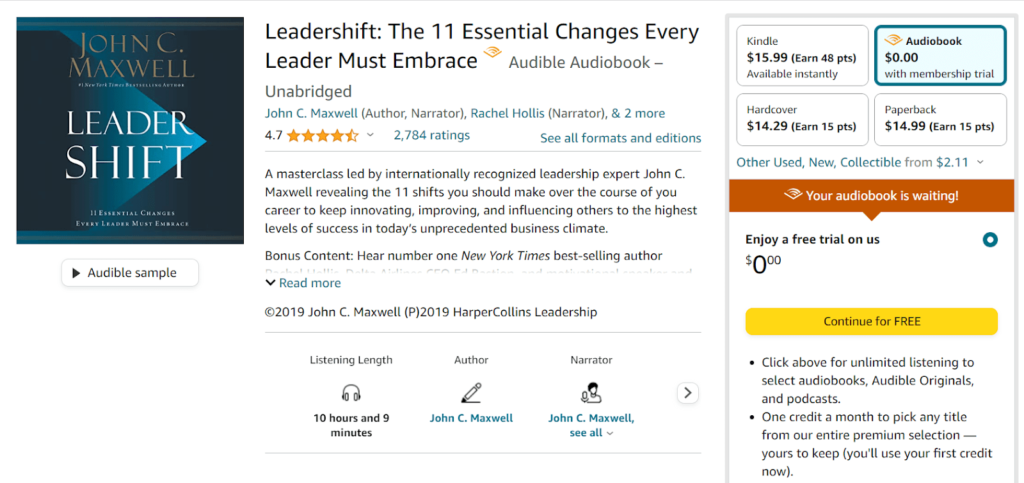
This book provides a dynamic and insightful exploration of leadership in the face of today’s evolving world. By outlining 11 key shifts that leaders must embrace, the author creates a comprehensive framework for adapting to the challenges and opportunities presented by change. It talks about shifting from soloist to conductor to transitioning from goals to growth.
By pinpointing these 11 shifts and offering practical illustrations, the book has become a compass for leaders seeking to drive substantial change within their organizations. Maxwell’s years of research go beyond surface-level adjustments, and so it is more about nurturing a mindset and cultivating behaviors that facilitate continuous adaptation.
The ideas range from prioritizing people’s approval to daring to challenge them to the evolution from seeking uniformity within teams to embracing diverse perspectives.
USP: The book’s unique selling point lies in its dual focus on adapting leadership strategies to navigate a constantly changing world and nurturing personal leadership development. Maxwell’s book doesn’t merely offer a formula for managing change but delves deeper, emphasizing the critical shifts leaders must make to drive their growth while effectively leading their teams through change.
#8. The Theory and Practice of Change Management by John Hayes
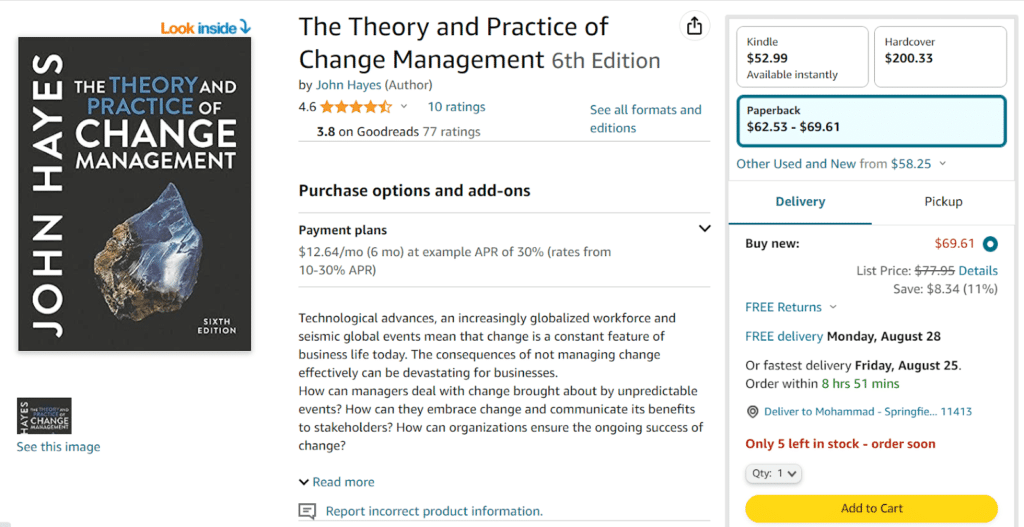
This book, authored by John Hayes, is a unique resource that dives deeper into the theoretical underpinnings of change management and offers concrete tools for real-world application. Hayes explores various change management models, strategies, and techniques within its pages, providing readers with a comprehensive understanding of the subject.
One of the notable strengths of this book is its in-depth coverage of different change management models, including Lewin’s Three-Step Model, Kotter’s Eight-Step Model, and the ADKAR Model. Hayes walks readers through the intricacies of these models, shedding light on their nuances and practical implementation within organizational contexts.
The book addresses the crucial aspect of resistance to change, offering insights into its underlying causes and strategies to manage and mitigate it effectively.
He also bridges the gap between academic concepts and practical application by offering case studies and real-world examples illustrating how these models and techniques have been successfully employed.
USP: This book not only delves into the theoretical knowledge of change management but also provides a robust toolkit comprising models, tools, and techniques that are directly applicable to real-world scenarios, setting it apart from other books in the market.
#9. Doing Agile Right: Transformation Without Chaos by Darrell Rigby, Sarah Elk, and Steve Berez
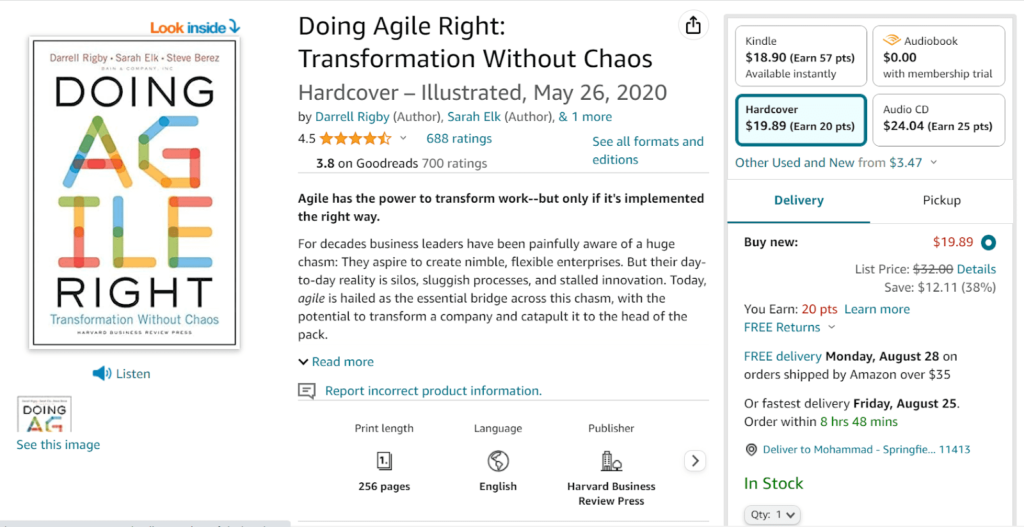
This book offers a unique perspective that bridges the gap between agile practices and substantial organizational change and connects them together. While not solely a change management book, it dives into the process of implementing agile methodologies, shedding light on how they foster adaptability and responsiveness.
The book also recognizes that embracing agile practices entails more than adopting a new approach. It necessitates a broader shift in organizational dynamics, leadership styles, and cultural norms. Furthermore, it delves into the transformative potential of agile practices, illustrating how they foster cross-functional collaboration, iterative improvements, and a culture of relentless innovation.
USP: Unlike other books in the market, the book explores Agile methodologies for effective change management. It offers insights into applying Agile principles beyond software development to drive organizational transformation.
Conclusion
The array of change management books we have discussed offers a comprehensive toolkit for professionals in the changing business dynamics. From understanding emotions during change to structured processes and psychological insights, each book contributes a unique perspective.
Leadership’s pivotal role is emphasized, and diverse viewpoints from thought leaders enrich the understanding. The blend of theory and practice ensures a well-rounded grasp of change management, while storytelling and agile principles offer innovative approaches. This collection equips readers to navigate the complexities of change effectively.
Disclosure: Some links in this post are affiliate links, and I will earn a commission if you purchase after clicking. Please understand that I recommend these resources because they are useful, not just because of my commissions. Please do not purchase unless you need the materials to achieve your goals.

I am Mohammad Fahad Usmani, B.E. PMP, PMI-RMP. I have been blogging on project management topics since 2011. To date, thousands of professionals have passed the PMP exam using my resources.

